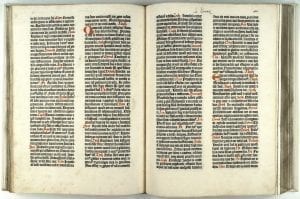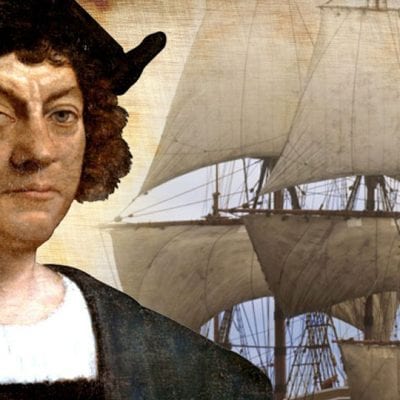Though it is not certain, many scholars agree that the Gutenberg Bible was published in Mainz, Germany on this day. The printing of the Gutenberg Latin language Bible was one of the most significant events that took place in human history. Prior to 1455, books were mainly in possessions of very wealthy and influential people. The books were definitely not cheap. Copying was long, tedious work. For most of its long history, the Bible was copied by hand. It would take a single monk 20 years to transcribe it. The brilliant invention of Johann Gutenberg’s printing press, helped to popularize books and the information they contained.
His invention revolutionized the distribution of knowledge by making it possible to produce many accurate copies of a single work. Thus, the printed books could easier reach much wider population. Gutenberg was not a rich man, but he wanted to spread books, so he borrowed money in 1448, invented and built his printing press, which used movable type. He made little money from his printing system but in 1455, he was able to demonstrate the power of the printing press by selling copies of a two-volume Bible (Biblia Sacra) for 300 florins each.
This was the equivalent of approximately three years’ wages for an average clerk, but it was significantly cheaper than a handwritten Bible. It is not known how many copies of the Bible were printed–estimates suggest about 150 to 180. Today, 48 copies in a variety of states are in existence. Complete vellum copies may be found in Paris’s Bibliotheque Nationale, London’s British Library, Washington, D.C.’s Library of Congress and Göttingen State and University Library in Germany. Additional incomplete and paper copies are scattered across the world in educational institutions and private collections.
 Historians think Gutenberg printed about 160-180 Bibles in 1455. Today, 48 Gutenberg Bibles survive in whole or in part. Although Gutenberg Bibles were still relatively rare and expensive, the technology set off the so-called “Gutenberg Revolution,” which made books and knowledge available to almost all literate people.
Historians think Gutenberg printed about 160-180 Bibles in 1455. Today, 48 Gutenberg Bibles survive in whole or in part. Although Gutenberg Bibles were still relatively rare and expensive, the technology set off the so-called “Gutenberg Revolution,” which made books and knowledge available to almost all literate people.
The impact? A leap forward in education. Prior to the mass production allowed by the Gutenberg press, there was little need for people to know how to read. It was likely that they might have gone through their lives rarely ever seeing a book and perhaps only a handwritten Bible when they attended church. Therefore, illiteracy was not only a way of life, it was pretty much the way of life. Why learn to read if you are never going to have the opportunity to utilize that skill? With the Gutenberg press, books and writings became more common because they could be mass produced and distributed far and wide. Thus, the knowledge from others could be imparted to the masses instead of just to the rich that could afford the time and expense of traveling to some nobleman’s or church’s library to read a handwritten book. Literacy became more important. And that literacy allowed people to learn past knowledge left as a record by others and build upon it.
This is an interesting 1998 article below from the Washington Post on the history of Newspapers:
Gutenberg’s Press Started a Revolution
In the 50 years after Gutenberg started printing, an estimated 500,000 books were in circulation, printed on about 1,000 presses across the continent. Gutenberg’s invention was a simple device, but it launched a revolution marked by repeated advances in technology and, as a result, a popularization of the ideals of liberty and freedom of information exchange. The first publications that could be called “newspapers” appeared in Strasbourg and in Wolfenbuttel in Germany in 1609. They distinguished themselves from other printed material by being published on a regular basis. They reported on a variety of current events to a broad public audience.
 Within a few decades, newspapers could be found in all the major cities of Europe, from Venice to London. The power of the press to foment trouble had been well established. In 1517, Martin Luther rocked the Roman Catholic Church with his “95 Theses,” in which he decried the clergy’s abuses of power. Thanks to the printing press, copies of the theses and news of its posting circulated widely in Europe, eventually forcing a rift in the church and ending its long religious supremacy. Europe’s monarchs, fearing for their own prerogative, kept a sharp eye on printers, requiring them to obtain official license.
Within a few decades, newspapers could be found in all the major cities of Europe, from Venice to London. The power of the press to foment trouble had been well established. In 1517, Martin Luther rocked the Roman Catholic Church with his “95 Theses,” in which he decried the clergy’s abuses of power. Thanks to the printing press, copies of the theses and news of its posting circulated widely in Europe, eventually forcing a rift in the church and ending its long religious supremacy. Europe’s monarchs, fearing for their own prerogative, kept a sharp eye on printers, requiring them to obtain official license.
In England, the notorious Star Chamber, an often secret, non-jury tribunal, enforced the royal line with a heavy hand, ordering, for example, the execution of William Carter in 1584 for publishing pro-Catholic pamphlets. The first serious challenge to this order came during the English Civil War in the 1640s when King Charles I and his Cavaliers warred against the insurgent Long Parliament. The Star Chamber was abolished in 1641, and the poet John Milton, emboldened by the resulting power vacuum, published “Areopagitica,” his polemic against censorship, in 1644. His was the first significant argument for freedom of the press.
“Truth,” Milton wrote, “needs no licensing to make her victorious.” Unfortunately, Milton didn’t help the cause when he later took over licensing printers for the government under England’s Lord Protector, Oliver Cromwell. The power to license is, of course, the power to deny a license. Milton’s pamphlet was based on the notion that reason and fact could be used to question tradition and challenge supposed “truth.” It was a radical idea that gained popularity among Europe’s educated people, thanks in large part to newspapers. Just 10 years earlier, the Gazette de France had carried reports of Galileo Galilei’s heresy trial. Galileo, too, had been arguing for truth, advocating a separation of science and religion.
By 1695, licensing the press had become so unpopular in England that Parliament abolished it. But that did not end censorship. The government simply turned to enforcing its will through libel laws, which forbade criticism of the government, true or not. In fact, the rule of thumb in such cases was “the greater the truth, the greater the libel.” If criticism were based on fact, the logic went, there was an even greater possibility that it could undermine the existing order. About this time, the first newspaper appeared in that hotbed of insurrection, the American colonies.
In 1690, Publick Occurrences was published in Boston. Its first issue reported, “The Christianized Indians in some parts of Plimouth {sic}, have newly appointed a day of Thanksgiving.” It also noted that the king of France was sleeping with his daughter-in-law. Agents of the restored British monarchy, alarmed by this impertinence, quickly shut down the paper after one edition. Despite censorship, newspapers sprouted across the colonies and continued to pester the crown. Events came to a head in 1735 when newspaper publisher John Peter Zenger was put on trial, charged with seditious libel. Sedition is incitement of rebellion against a government. Zenger had been doing a booming business, printing controversial material that official printers for the provincial government couldn’t accept.
Two years earlier, he had founded the New York Weekly Journal with the backing of several prominent critics of New York’s unpopular royal governor. The paper regularly decried his incompetence, and it was only a matter of time before Zenger was jailed. Faced with a hostile judge, Zenger’s lawyer, Andrew Hamilton, argued for truth as a defense of libel, a radical strategy: “It is the cause of liberty . . . the liberty of exposing and opposing arbitrary power (in these parts of the world at least) by speaking and writing truth.” The judge instructed the jury to determine only whether Zenger had published the material and said he alone would consider the question of libel. The jury, however, ignored the instructions and returned a verdict of not guilty, establishing a precedent in American press law.
The crown was undeterred. Strapped for cash after the French and Indian War (1754-63), the government realized that it could raise desperately needed funds and regulate newspapers through its power to tax. The infamous Stamp Act of 1765 required printers to pay for a stamp on each sheet of paper and for each advertisement. Imposed during the postwar economic depression, the tax was a serious burden. William Bradford adorned the front page of his Pennsylvania Journal with tombstones, writing,”The publisher of this Paper, unable to bear the Burden, has thought it expedient to STOP a while in order to deliberate, whether any Methods can be found to elude the Chains forged for us.” Insurgent colonists convened the Stamp Act Congress in New York City and declared firm opposition to “taxation without representation.”
Colonial newspapers were so successful in arousing public resentment of the tax that it soon became unenforceable and was repealed in 1766. By 1775, 37 newspapers were being published in America. In those heady days before the Revolution, printers were at the front lines in the war of public opinion, representing all factions — patriot, Whig and Tory. Print shops were sacked regularly as violence escalated and the war of words intensified. Thomas Paine published his first “Crisis” paper in the Pennsylvania Journal Dec. 19, 1776, writing, “These are the times that try men’s souls. “Tyranny, like Hell, is not easily conquered; yet we have this consolation with us, that the harder the conflict, the more glorious the triumph.”
Recognizing the important role of newspapers and political pamphlets in forging the new republic, the Founding Fathers made sure that the first amendment to the Constitution said: “Congress shall make no law . . . abridging the freedom of speech, or of the press . . . . ” But the modern meaning of those words would not be understood immediately. In 1798, President John Adams signed the Alien and Sedition Acts, outlawing false, scandalous or malicious writing about the government or its officials. In practice, Adams, a Federalist, used the law to stifle his Republican critics, led by Thomas Jefferson. The question of whether the law violated the First Amendment was never decided because the Supreme Court had yet to adopt the practice of reviewing laws for constitutionality. That wouldn’t occur until 1803 when the court assumed that power in the landmark case of Marbury v. Madison. The controversial laws expired in 1801 and were not renewed.



